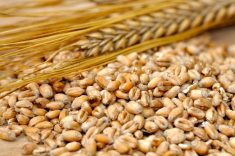Compared to last week, western Canadian yearling markets traded $2-$3/cwt on either side of unchanged. Prices for calves were also unchanged from average values seven days earlier. Calf markets are becoming more defined as volumes increase. There also appeared to be larger volume of high-quality yearlings available, which was a surprise. The drought hasn’t significantly altered the marketing schedule for cow-calf producers.
Alberta packers were buying fed cattle at $230/cwt f.o.b. the feedlot in southern Alberta, down $1/cwt from a week earlier. The deferred live cattle futures were consolidating at higher levels but the weaker Canadian dollar has underpinned the feeder market. U.S. feeder markets appeared to soften the last couple of weeks due to extreme heat. Yearlings coming into the feedlot don’t quite pencil out but the industry is bracing for a sharp year-over-year decline in beef production in the first half of 2024.
Read Also

U.S. livestock: Feeder cattle hit contract highs on tight supply
Chicago | Reuters – All Chicago Mercantile Exchange feeder cattle futures and most live cattle futures hit contract highs on…
Grass cattle remain hot. In central Alberta, mixed steers weighing 930 lbs. traded for $325. In central Saskatchewan a larger group of mixed steers weighing 940 lbs. were valued at $314 and in southern Manitoba, mixed steers weighing 920 lbs. were quoted at $305. In the Lethbridge area, a small group of Angus-based steers off grass weighing 850 lbs. dropped the gavel at $340 and similar-quality 904-lb. steers notched the charts at $329. At the same sale, yearling heifers weighing 929 lbs. sold for $320.
In central Saskatchewan, black mixed steers weighing 710 lbs. off grass reportedly traded for $361. South of Edmonton, mixed weaned heifers averaging 714 lbs. allegedly traded at $315. In the same region, mixed weaned steers off grass with a scale weight of 665 lbs. set the bar at $346. In central Saskatchewan, a small group of Charolais steers with a written weight of 610 lbs. supposedly were last bid at $370.
In northern Alberta, mixed steer calves weighing a shade over 500 lbs. sold for $375 and red mixed steers weighing 440 lbs. silenced the crowd at $405. West of Edmonton, Angus-blended steers weighing 541 lbs. were apparently sold for $386 and mixed heifers weighing 525 lbs. on the card at $350. In east-central Alberta, Limousin-based steers weighing 440 lbs. were quoted at $450.
Statistics Canada’s model-based crop survey had the barley crop at 7.9 million tonnes, down from 10 million tonnes last year. Canadian barley exports will be down sharply in the 2023-24 crop year. Last week, the first Australian barley vessel in three years loaded for China. Tunisia tendered for barley last week at a price of US$230/tonne, cost and freight. Canadian barley exports will be minimal and domestic feed barley demand is only about 5.5 million tonnes, given the amount of corn that’s traded into Western Canada. This is bullish for feeder cattle markets.
— Jerry Klassen is president and founder of Resilient Capital, specializing in proprietary commodity futures trading and market analysis. Jerry consults with feedlots on risk management and writes a weekly cattle market commentary. He can be reached at 204-504-8339 or via his website at ResilCapital.com.















